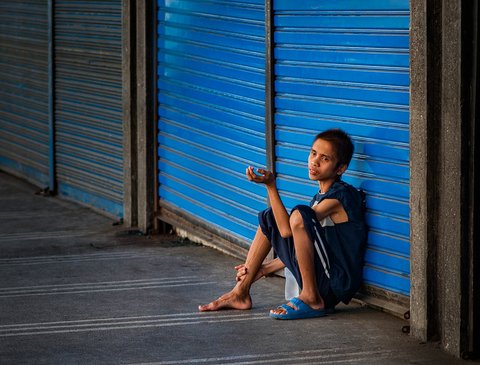
02 Mar COVID-19 Fuels the Threat of Global Famine

The COVID-19 pandemic has worsened food shortages and the risk of starvation throughout the world. (”Hunger” by Wayne S. Grazio via Flickr / CC BY-NC-ND 2.0. Taken June 3, 2015, in Bacolod, Visayas, Philippines.)
By Jenny Manrique, Ethnic Media Services
Conflicts, climate change and now COVID-19 are the three C’s driving 270 million people to famine in the most impoverished countries in Asia, the Middle East, Africa and Central and Latin America. Officials at the World Food Program, the hunger relief arm of the United Nations that feeds about a hundred million people each year in some 88 countries, warned that they are running out of resources to meet the demand for staple foods and thus prevent people dying from starvation.
“We are asking globally $13.5 billion for our budget this year, but we forecast being able to raise only about $7.8 billion,” said Steve Taravella, WFP’s senior spokesperson at a briefing organized by Ethnic Media Services on Feb. 26.
Before the pandemic, there were about 135 million people acutely hungry in the world, but the collateral economic impacts of the virus have doubled that number. WFP estimates that in 2021, about 19,000 officials working in developing countries will have to duplicate efforts to serve at least 120 million people, in hardest-hit places like Yemen, South Sudan, Nigeria and Burkina Faso.
“For some years, WFP and others working on global hunger were really effective in bringing hunger down to what we hoped would be the zero hunger goal of the UN by 2030. It’s pretty clear now, that’s not going to happen,” Taravella said. “COVID is making the poorest of the world poorer and the hungriest of the world hungrier.”
>>>Read: COVID-19 Impacting Immigration, Migration, World Hunger
WFP won the Nobel Peace Prize last year for its efforts to eradicate hunger in areas where natural disasters and conflict have disrupted normal food distribution channels. Areas where bombed roads prevent trucks carrying flour, rice, lentils, peas, cooking oil and salt from getting through. Areas where airstrikes destroy planes carrying dietary supplies. Areas where incessant fighting prevents hungry people from venturing out for food or aid workers from moving safely to provide it, at a time when crops cannot be harvested.
“There have been terrorist acts against villagers and aid workers by Al-Qaeda, Al-Shabaab, Boko Haram and ISIS,” Taravella said. Recently, a WFP staff member was killed in the Democratic Republic of the Congo while accompanying the Italian ambassador on a visit to a school feeding site.
WFP provides school meals in the classrooms, helps pregnant women and new mothers to understand nutrition, and supports small farmers to find markets for their produce.
“We work very closely with governments but we see ourselves there only as a temporary band-aid. Our goal is to help build the country’s capacity to manage the programs,” said Taravella.
Although the WFP does not operate food banks in the United States, immigrants in the country have contributed greatly to alleviating hunger in their homelands after natural disasters such as the typhoon that devastated the Philippines or the hurricanes in Central America. But COVID has also impacted remittances.
Devastating hurricanes
“When COVID hit, we were really hoping that the hurricane season will be a quiet one as we had a few years ago, but that was not the case,” said Elio Rujano, communications officer for the WFP’’s regional bureau for Central America and the Caribbean.
The 2020 season produced 30 named storms, of which 13 became hurricanes, six of them devastating in scope. Eta and Iota ravaged areas in Guatemala, Honduras and Nicaragua while tropical storm Amanda hit El Salvador. Since 2014, these countries have already been experiencing prolonged periods of droughts or excessive rains caused by the El Niño phenomenon, both causing the destruction of crops and the livelihood of farmer families.
“In the past we were only focusing on the dry corridor where rural farmers live, but now, because of the pandemic, hunger has expanded to urban areas,” Rujano said from his Panama City office. “50% of the labor in Latin America and Central America is informal labor. People work on the streets, and since they could no longer go out, they couldn’t meet their basic needs.”
Back in 2018, hunger in the region was affecting 2.2 million people and that number is approaching nearly 8 million in 2021.
Here, WFP works to support communities to become more resilient to climate change. They teach them to replace the plantation of fragile products such as beans and maize with beekeeping, since honey can be stored for longer periods. They also provide people with cash transfers to buy food at local shops and teach them about nutrition.
Rujano estimates that they could serve up to 2.6 million people this year if they reach $47 millions in donations to reach that population.






No Comments